Iranian vs Slovene Community Comparison
COMPARE
Iranian
Slovene
Social Comparison
Social Comparison
Iranians
Slovenes
9,682
SOCIAL INDEX
94.3/ 100
SOCIAL RATING
8th/ 347
SOCIAL RANK
8,224
SOCIAL INDEX
79.7/ 100
SOCIAL RATING
81st/ 347
SOCIAL RANK
Slovene Integration in Iranian Communities
The statistical analysis conducted on geographies consisting of 197,749,049 people shows a weak positive correlation between the proportion of Slovenes within Iranian communities in the United States with a correlation coefficient (R) of 0.241. On average, for every 1% (one percent) increase in Iranians within a typical geography, there is an increase of 0.004% in Slovenes. To illustrate, in a geography comprising of 100,000 individuals, a rise of 1,000 Iranians corresponds to an increase of 4.5 Slovenes.
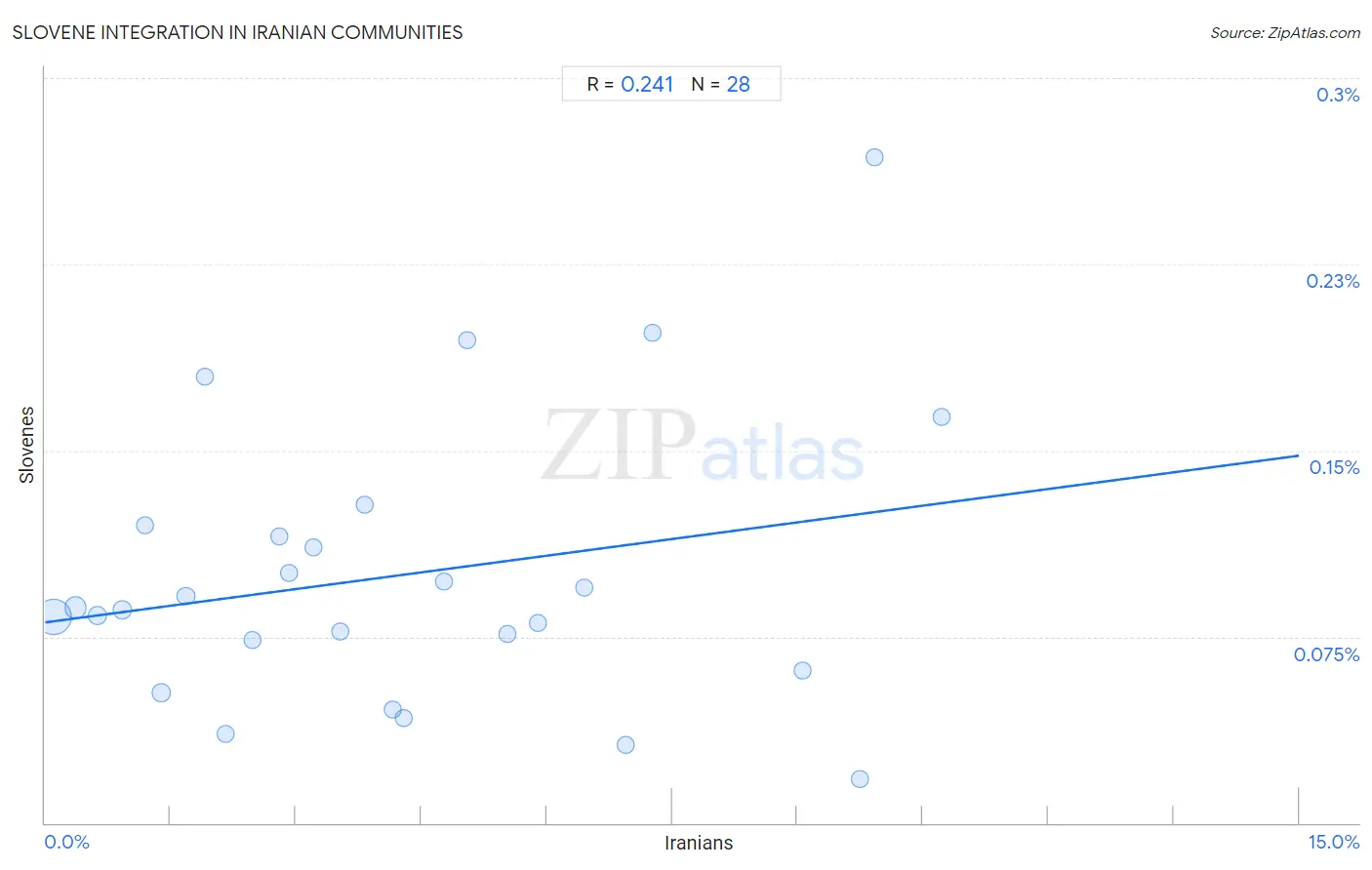
Iranian vs Slovene Income
When considering income, the most significant differences between Iranian and Slovene communities in the United States are seen in per capita income ($58,786 compared to $45,581, a difference of 29.0%), householder income over 65 years ($77,429 compared to $60,241, a difference of 28.5%), and median household income ($109,835 compared to $85,562, a difference of 28.4%). Conversely, both communities are more comparable in terms of wage/income gap (29.7% compared to 28.3%, a difference of 5.1%), householder income under 25 years ($55,548 compared to $50,886, a difference of 9.2%), and median female earnings ($47,421 compared to $39,817, a difference of 19.1%).

| Income Metric | Iranian | Slovene |
| Per Capita Income | Exceptional $58,786 | Excellent $45,581 |
| Median Family Income | Exceptional $133,839 | Excellent $106,020 |
| Median Household Income | Exceptional $109,835 | Average $85,562 |
| Median Earnings | Exceptional $58,474 | Excellent $47,995 |
| Median Male Earnings | Exceptional $70,648 | Exceptional $57,145 |
| Median Female Earnings | Exceptional $47,421 | Average $39,817 |
| Householder Age | Under 25 years | Exceptional $55,548 | Tragic $50,886 |
| Householder Age | 25 - 44 years | Exceptional $120,292 | Good $96,439 |
| Householder Age | 45 - 64 years | Exceptional $129,350 | Good $102,885 |
| Householder Age | Over 65 years | Exceptional $77,429 | Fair $60,241 |
| Wage/Income Gap | Tragic 29.7% | Tragic 28.3% |
Iranian vs Slovene Poverty
When considering poverty, the most significant differences between Iranian and Slovene communities in the United States are seen in receiving food stamps (7.9% compared to 9.8%, a difference of 23.7%), child poverty under the age of 5 (13.1% compared to 16.0%, a difference of 22.2%), and single father poverty (14.4% compared to 17.3%, a difference of 20.6%). Conversely, both communities are more comparable in terms of male poverty (9.8% compared to 10.0%, a difference of 2.0%), poverty (10.7% compared to 11.0%, a difference of 2.2%), and female poverty (11.7% compared to 12.0%, a difference of 2.8%).
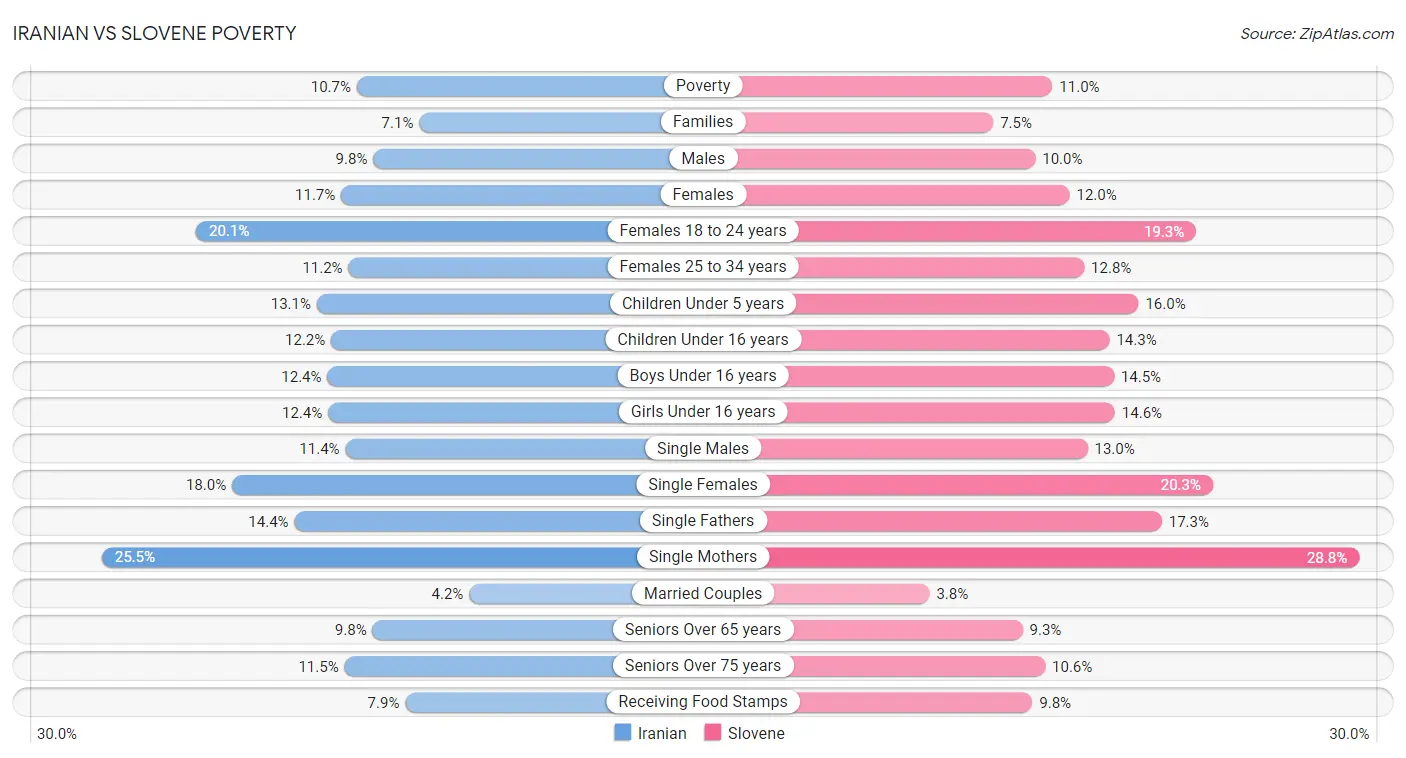
| Poverty Metric | Iranian | Slovene |
| Poverty | Exceptional 10.7% | Exceptional 11.0% |
| Families | Exceptional 7.1% | Exceptional 7.5% |
| Males | Exceptional 9.8% | Exceptional 10.0% |
| Females | Exceptional 11.7% | Exceptional 12.0% |
| Females 18 to 24 years | Average 20.1% | Exceptional 19.3% |
| Females 25 to 34 years | Exceptional 11.2% | Exceptional 12.8% |
| Children Under 5 years | Exceptional 13.1% | Exceptional 16.0% |
| Children Under 16 years | Exceptional 12.2% | Exceptional 14.3% |
| Boys Under 16 years | Exceptional 12.4% | Exceptional 14.5% |
| Girls Under 16 years | Exceptional 12.4% | Exceptional 14.6% |
| Single Males | Exceptional 11.4% | Fair 13.0% |
| Single Females | Exceptional 18.0% | Exceptional 20.3% |
| Single Fathers | Exceptional 14.4% | Tragic 17.3% |
| Single Mothers | Exceptional 25.5% | Good 28.8% |
| Married Couples | Exceptional 4.2% | Exceptional 3.8% |
| Seniors Over 65 years | Exceptional 9.8% | Exceptional 9.3% |
| Seniors Over 75 years | Exceptional 11.5% | Exceptional 10.6% |
| Receiving Food Stamps | Exceptional 7.9% | Exceptional 9.8% |
Iranian vs Slovene Unemployment
When considering unemployment, the most significant differences between Iranian and Slovene communities in the United States are seen in unemployment among seniors over 75 years (7.9% compared to 9.3%, a difference of 17.5%), female unemployment (5.3% compared to 4.5%, a difference of 16.8%), and unemployment among ages 60 to 64 years (5.0% compared to 4.4%, a difference of 13.9%). Conversely, both communities are more comparable in terms of unemployment among ages 30 to 34 years (5.2% compared to 5.2%, a difference of 0.090%), unemployment among ages 25 to 29 years (6.3% compared to 6.3%, a difference of 0.17%), and unemployment among ages 35 to 44 years (4.5% compared to 4.4%, a difference of 1.2%).
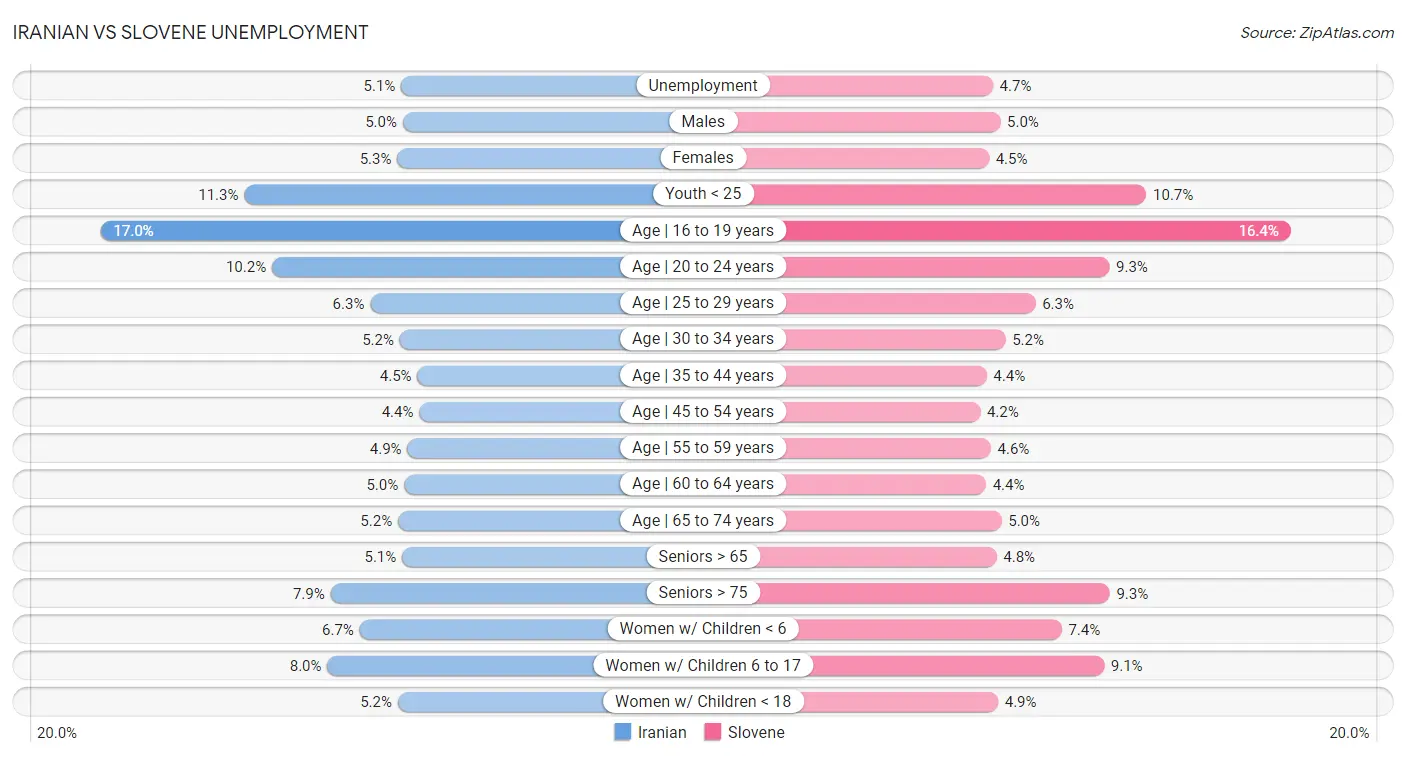
| Unemployment Metric | Iranian | Slovene |
| Unemployment | Excellent 5.1% | Exceptional 4.7% |
| Males | Exceptional 5.0% | Exceptional 5.0% |
| Females | Average 5.3% | Exceptional 4.5% |
| Youth < 25 | Exceptional 11.3% | Exceptional 10.7% |
| Age | 16 to 19 years | Exceptional 17.0% | Exceptional 16.4% |
| Age | 20 to 24 years | Good 10.2% | Exceptional 9.3% |
| Age | 25 to 29 years | Exceptional 6.3% | Exceptional 6.3% |
| Age | 30 to 34 years | Exceptional 5.2% | Exceptional 5.2% |
| Age | 35 to 44 years | Exceptional 4.5% | Exceptional 4.4% |
| Age | 45 to 54 years | Exceptional 4.4% | Exceptional 4.2% |
| Age | 55 to 59 years | Fair 4.9% | Exceptional 4.6% |
| Age | 60 to 64 years | Tragic 5.0% | Exceptional 4.4% |
| Age | 65 to 74 years | Exceptional 5.2% | Exceptional 5.0% |
| Seniors > 65 | Excellent 5.1% | Exceptional 4.8% |
| Seniors > 75 | Exceptional 7.9% | Tragic 9.3% |
| Women w/ Children < 6 | Exceptional 6.7% | Excellent 7.4% |
| Women w/ Children 6 to 17 | Exceptional 8.0% | Fair 9.1% |
| Women w/ Children < 18 | Excellent 5.2% | Exceptional 4.9% |
Iranian vs Slovene Labor Participation
When considering labor participation, the most significant differences between Iranian and Slovene communities in the United States are seen in in labor force | age 16-19 (33.0% compared to 43.7%, a difference of 32.3%), in labor force | age 20-24 (72.6% compared to 78.7%, a difference of 8.5%), and in labor force | age 25-29 (84.8% compared to 86.4%, a difference of 1.8%). Conversely, both communities are more comparable in terms of in labor force | age 30-34 (85.4% compared to 85.6%, a difference of 0.23%), in labor force | age 20-64 (80.0% compared to 80.5%, a difference of 0.57%), and in labor force | age 45-54 (83.2% compared to 83.9%, a difference of 0.82%).

| Labor Participation Metric | Iranian | Slovene |
| In Labor Force | Age > 16 | Exceptional 66.0% | Poor 64.9% |
| In Labor Force | Age 20-64 | Exceptional 80.0% | Exceptional 80.5% |
| In Labor Force | Age 16-19 | Tragic 33.0% | Exceptional 43.7% |
| In Labor Force | Age 20-24 | Tragic 72.6% | Exceptional 78.7% |
| In Labor Force | Age 25-29 | Good 84.8% | Exceptional 86.4% |
| In Labor Force | Age 30-34 | Exceptional 85.4% | Exceptional 85.6% |
| In Labor Force | Age 35-44 | Good 84.5% | Exceptional 85.6% |
| In Labor Force | Age 45-54 | Exceptional 83.2% | Exceptional 83.9% |
Iranian vs Slovene Family Structure
When considering family structure, the most significant differences between Iranian and Slovene communities in the United States are seen in births to unmarried women (25.3% compared to 31.2%, a difference of 23.2%), divorced or separated (10.8% compared to 12.3%, a difference of 13.4%), and single mother households (5.0% compared to 5.6%, a difference of 12.9%). Conversely, both communities are more comparable in terms of currently married (48.6% compared to 48.1%, a difference of 0.99%), family households (63.9% compared to 62.4%, a difference of 2.3%), and average family size (3.18 compared to 3.07, a difference of 3.6%).

| Family Structure Metric | Iranian | Slovene |
| Family Households | Poor 63.9% | Tragic 62.4% |
| Family Households with Children | Excellent 27.7% | Tragic 25.8% |
| Married-couple Households | Exceptional 49.0% | Excellent 47.1% |
| Average Family Size | Tragic 3.18 | Tragic 3.07 |
| Single Father Households | Exceptional 1.9% | Exceptional 2.2% |
| Single Mother Households | Exceptional 5.0% | Exceptional 5.6% |
| Currently Married | Exceptional 48.6% | Exceptional 48.1% |
| Divorced or Separated | Exceptional 10.8% | Poor 12.3% |
| Births to Unmarried Women | Exceptional 25.3% | Good 31.2% |
Iranian vs Slovene Vehicle Availability
When considering vehicle availability, the most significant differences between Iranian and Slovene communities in the United States are seen in no vehicles in household (8.6% compared to 8.0%, a difference of 6.4%), 4 or more vehicles in household (6.5% compared to 6.3%, a difference of 2.0%), and 1 or more vehicles in household (91.5% compared to 92.0%, a difference of 0.59%). Conversely, both communities are more comparable in terms of 3 or more vehicles in household (20.1% compared to 20.2%, a difference of 0.21%), 2 or more vehicles in household (58.1% compared to 58.3%, a difference of 0.37%), and 1 or more vehicles in household (91.5% compared to 92.0%, a difference of 0.59%).

| Vehicle Availability Metric | Iranian | Slovene |
| No Vehicles Available | Exceptional 8.6% | Exceptional 8.0% |
| 1+ Vehicles Available | Exceptional 91.5% | Exceptional 92.0% |
| 2+ Vehicles Available | Exceptional 58.1% | Exceptional 58.3% |
| 3+ Vehicles Available | Excellent 20.1% | Excellent 20.2% |
| 4+ Vehicles Available | Good 6.5% | Average 6.3% |
Iranian vs Slovene Education Level
When considering education level, the most significant differences between Iranian and Slovene communities in the United States are seen in doctorate degree (3.1% compared to 1.9%, a difference of 66.0%), professional degree (7.6% compared to 4.6%, a difference of 66.0%), and master's degree (22.3% compared to 15.5%, a difference of 43.4%). Conversely, both communities are more comparable in terms of 4th grade (98.0% compared to 98.4%, a difference of 0.46%), nursery school (98.2% compared to 98.7%, a difference of 0.49%), and kindergarten (98.2% compared to 98.7%, a difference of 0.49%).
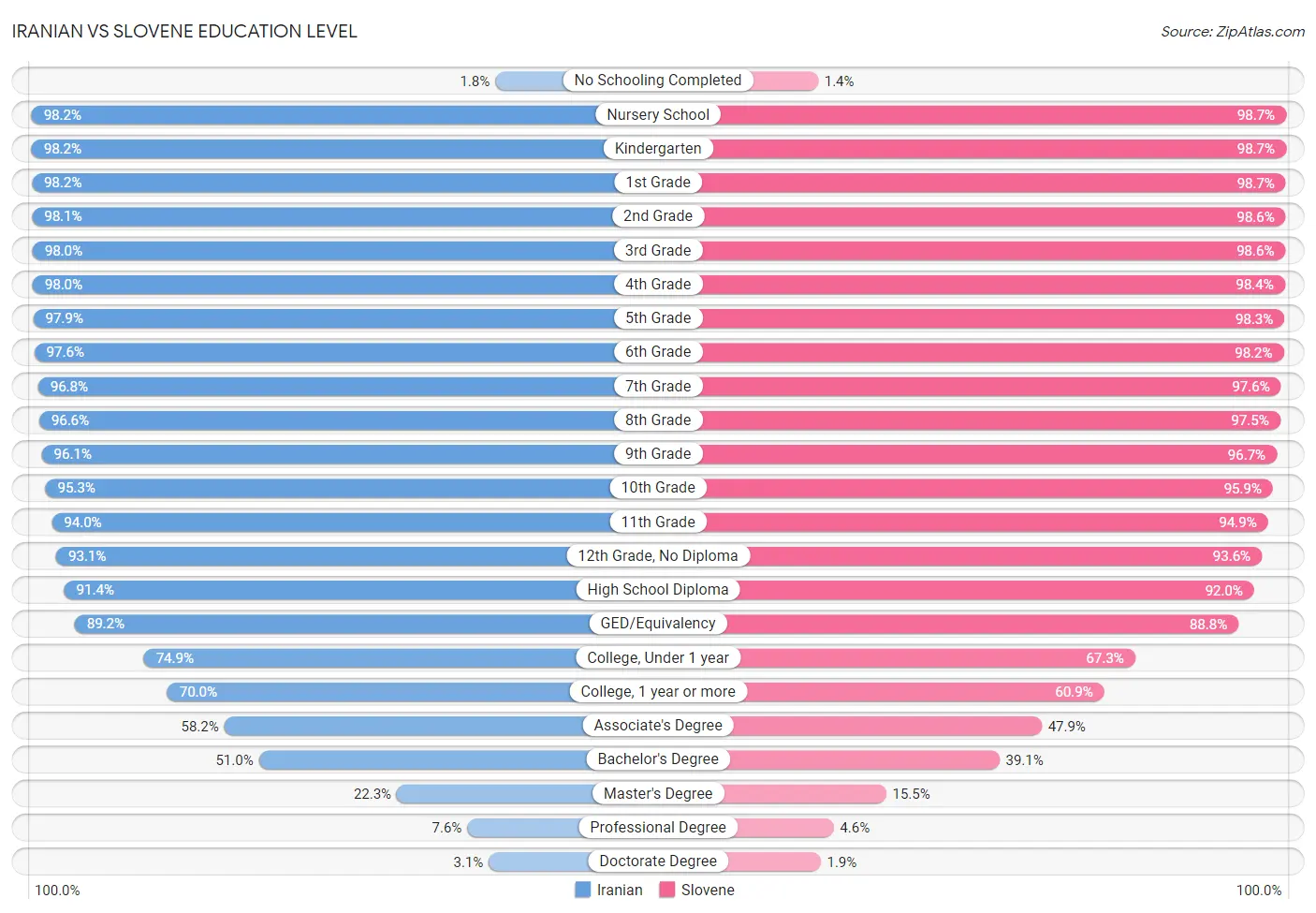
| Education Level Metric | Iranian | Slovene |
| No Schooling Completed | Exceptional 1.8% | Exceptional 1.4% |
| Nursery School | Exceptional 98.2% | Exceptional 98.7% |
| Kindergarten | Exceptional 98.2% | Exceptional 98.7% |
| 1st Grade | Exceptional 98.2% | Exceptional 98.7% |
| 2nd Grade | Exceptional 98.1% | Exceptional 98.6% |
| 3rd Grade | Exceptional 98.0% | Exceptional 98.6% |
| 4th Grade | Exceptional 98.0% | Exceptional 98.4% |
| 5th Grade | Exceptional 97.9% | Exceptional 98.3% |
| 6th Grade | Exceptional 97.6% | Exceptional 98.2% |
| 7th Grade | Exceptional 96.8% | Exceptional 97.6% |
| 8th Grade | Exceptional 96.6% | Exceptional 97.5% |
| 9th Grade | Exceptional 96.1% | Exceptional 96.7% |
| 10th Grade | Exceptional 95.3% | Exceptional 95.9% |
| 11th Grade | Exceptional 94.0% | Exceptional 94.9% |
| 12th Grade, No Diploma | Exceptional 93.1% | Exceptional 93.6% |
| High School Diploma | Exceptional 91.4% | Exceptional 92.0% |
| GED/Equivalency | Exceptional 89.2% | Exceptional 88.8% |
| College, Under 1 year | Exceptional 74.9% | Exceptional 67.3% |
| College, 1 year or more | Exceptional 70.0% | Excellent 60.9% |
| Associate's Degree | Exceptional 58.2% | Excellent 47.9% |
| Bachelor's Degree | Exceptional 51.0% | Good 39.1% |
| Master's Degree | Exceptional 22.3% | Good 15.5% |
| Professional Degree | Exceptional 7.6% | Good 4.6% |
| Doctorate Degree | Exceptional 3.1% | Good 1.9% |
Iranian vs Slovene Disability
When considering disability, the most significant differences between Iranian and Slovene communities in the United States are seen in disability age under 5 (1.0% compared to 1.4%, a difference of 35.7%), disability age 35 to 64 (8.7% compared to 11.4%, a difference of 31.6%), and disability age 5 to 17 (4.6% compared to 6.0%, a difference of 29.4%). Conversely, both communities are more comparable in terms of cognitive disability (16.5% compared to 16.5%, a difference of 0.30%), disability age over 75 (45.9% compared to 45.6%, a difference of 0.61%), and self-care disability (2.3% compared to 2.4%, a difference of 4.7%).
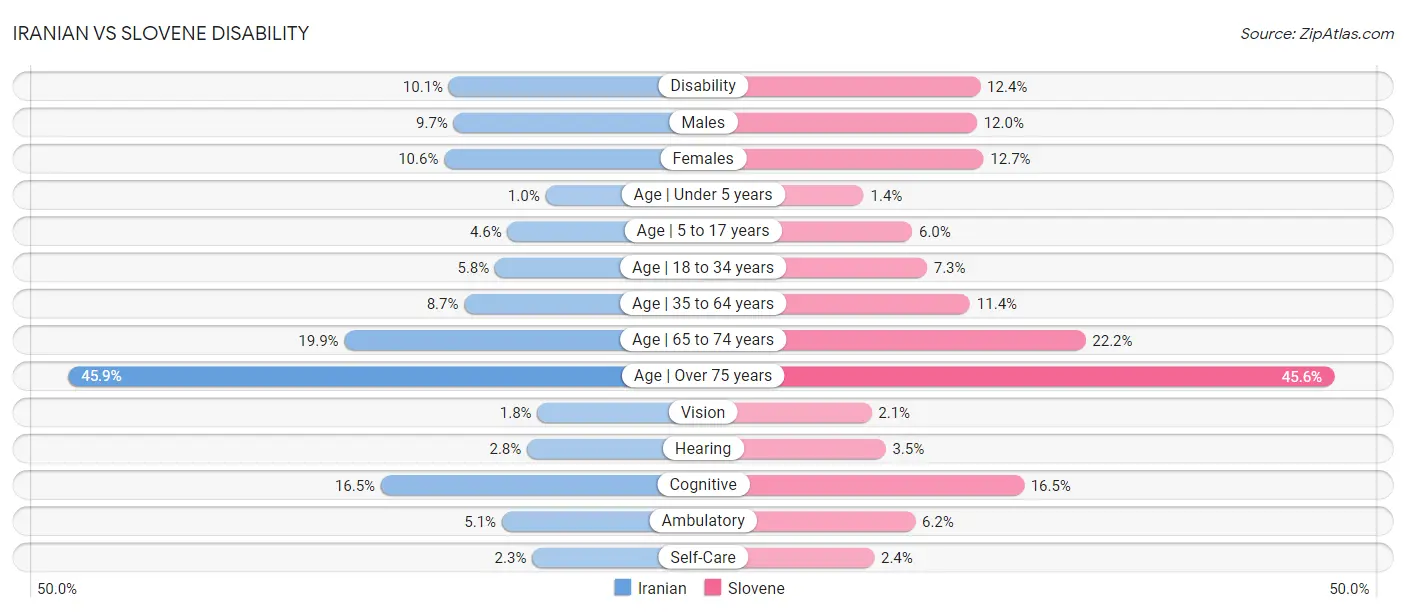
| Disability Metric | Iranian | Slovene |
| Disability | Exceptional 10.1% | Tragic 12.4% |
| Males | Exceptional 9.7% | Tragic 12.0% |
| Females | Exceptional 10.6% | Tragic 12.7% |
| Age | Under 5 years | Exceptional 1.0% | Tragic 1.4% |
| Age | 5 to 17 years | Exceptional 4.6% | Tragic 6.0% |
| Age | 18 to 34 years | Exceptional 5.8% | Tragic 7.3% |
| Age | 35 to 64 years | Exceptional 8.7% | Fair 11.4% |
| Age | 65 to 74 years | Exceptional 19.9% | Exceptional 22.2% |
| Age | Over 75 years | Exceptional 45.9% | Exceptional 45.6% |
| Vision | Exceptional 1.8% | Good 2.1% |
| Hearing | Exceptional 2.8% | Tragic 3.5% |
| Cognitive | Exceptional 16.5% | Exceptional 16.5% |
| Ambulatory | Exceptional 5.1% | Poor 6.2% |
| Self-Care | Exceptional 2.3% | Exceptional 2.4% |